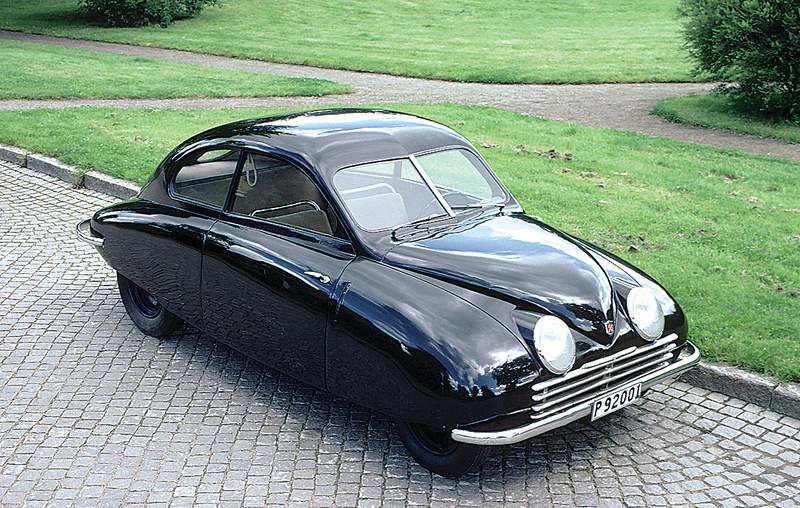Stalking the Saab that soared
Published 4:00 am Friday, November 27, 2009

- Saab, which started as an airplane company, designed its earlier cars using aeronautic principles to provide optimal aerodynamics and minimal wind resistance. Seen here is a 1947 Saab prototype.
Saab is a relatively young and proudly offbeat automaker, and from the start it has appealed to those who appreciate the unconventional.
For some aficionados, “Find your own road” was more than a slogan.
Now, with the company in ownership limbo — on Tuesday, a group led by Sweden’s Koenigsegg Automotive AB dropped out of a deal to buy Saab from General Motors — its future is murky, to say the least. But whatever comes, the Saab legacy is secure, including an innovative streak that helped to transform an aircraft maker into a car company that packed personality into every model.
Saab is an acronym for Svenska Aeroplan Aktiebolaget, or Swedish Airplane Company, founded in 1937 to build planes for the Swedish Air Force. After the war (during which Sweden remained neutral) Saab turned to auto production to keep its plants running. As its engineers shifted from aeronautics to automobiles, they introduced some unorthodox approaches. (In those early days, engineers — not marketers — called the shots at Saab.)
Relying on proven aircraft principles, the first Saabs had a teardrop shape for optimal aerodynamics and minimal wind resistance. From the side, the cars resembled a cross-section of a wing, and the design, which resembled an airplane fuselage, was both light and strong, and also relatively spacious.
Given that basic logic and family values are intrinsic to Swedish culture, along with an appreciation for simple but elegant engineering, a 2-stroke engine was first specified instead of the more common 4-stroke motor. A 2-stroke is small, light, simple to make, easy to maintain and powerful for its size.
The first production model was dubbed 92 — the next number in the sequence of Saab aircraft projects. That car appeared in 1949 and had just 2 cylinders. It also had front-wheel drive, highly unusual at the time, which made it easier to get around in harsh Swedish winters; the flat floor also made the cabin more useful. Front drive would become a distinguishing characteristic of all Saabs until after GM absorbed the company in 2000.
The 92 distinguished itself in rally competitions, despite a serious shortage of power, and quickly evolved into the 3-cylinder Saab 93. The 93 made its American debut at the 1956 New York auto show and the next year became the first Saab officially imported into the United States.
By the late 1960s, the 2-stroke engine finally succumbed to new emissions standards. In 1967, Saab began using a 4-stroke V-4 engine obtained from Ford of Europe. By then, Saab was already selling an improved version of the 93 called the 96. The 95 wagon and the Sonett sports car were re-engineered to accept the 4-stroke engine as well.
The next model to emerge was the 99, in 1969. (The project number for the Sonett was 97, and 98 was an airplane designation.)
The 99 was bigger and boxier than the 96, but still packed with innovations. To help it slip through the air and simultaneously keep occupants out of harm’s way, it featured a heavily bowed windshield — so much that it proved a challenge to develop windshield wipers that followed the pronounced curvature.
Another new safety feature that would become a Saab hallmark was the floor-mounted ignition switch. Since it was then common to situate the ignition switch on the dashboard, the idea was to move it to a place where the key wouldn’t maim the driver’s knee in a crash.
In 1969, Saab merged with Scania, the Swedish maker of heavy-duty trucks, and gained engine-making expertise. By 1972, Saab was building its own engines.
The 99 EMS, a model that had sporting pretensions but little under the hood to back them up, was soon blessed with a turbocharged engine. A Saab legend was born: the 99 Turbo was one of the earliest executive-class sport sedans, not only fast but fairly economical.
A Swedish surprise?
That car was short-lived, given that the 99 was replaced in 1979 by the 900 — essentially, a 99 with a longer front end for improved crashworthiness. The 900 was offered with a turbo, too, but may be best remembered as the basis for another Swedish surprise.
At the insistence of Saab’s American importer, the company cut the roof off the car to create the 900 Convertible. At the time, new convertibles had all but disappeared from the market; Saab thus virtually reinvented the modern four-passenger convertible.
As Saab continued to move upscale, it brought out a bigger and more luxurious offering, the 9000, in 1986. Often called the last true Saab by the cognoscenti, this car was the product of a joint venture with Fiat, Alfa Romeo and Lancia. Still, Saab’s engineers managed to inject a dose of their Swedish safety ethic into the multinational effort.
The 9000 was available as a stately sedan and, more significantly, as a practical hatchback. The line included the 9000 Aero hatchback, which could be seen as the ultimate Saab, given its combination of performance and practicality; enthusiasts have called it “a five-door Porsche.”
Today, classic Saabs are becoming more sought after by fanatically loyal collectors who appreciate their engineering virtues, fun-to-drive factor, practicality and safety — the same attributes that set the cars apart when they rolled out of the factory in Trollhattan.






